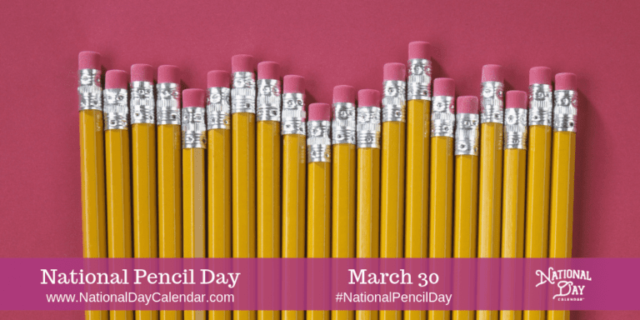
Each year, March 30th is National Pencil Day.
- Hymen Lipman received the first patent for attaching an eraser to the end of a pencil on this day in 1858.
- The majority of these writing utensils made in the United States are painted yellow.
- It is believed that this tradition began in 1890 when the L & C Hardtmuth Company of Austria-Hungary introduced their Koh-I-Noor brand, named after the famous diamond. This pencil was intended to be the world’s best and most expensive pencil.
- Other companies then began to copy the yellow color so that their pencils would be associated with the high-quality brand.
- Thomas Edison had his pencils specially made by Eagle Pencil. Each pencil was three inches long, was thicker than standard pencils and had softer graphite than was typically available.
- Vladimir Nabokov rewrote everything he had ever published, usually several times, by pencil.
- John Steinbeck was an obsessive pencil user and is said to have used as many as 60 a day. His novel East of Eden took more than 300 pencils to write.
- Vincent van Gogh used only Faber pencils as they were “superior to Carpenters pencils, a capital black and most agreeable.”
- Johnny Carson regularly played with pencils at his Tonight Show desk. These pencils were specially made with erasers at both ends to avoid on-set accidents.
- Roald Dahl used only pencils with yellow casing to write his books. He had six sharpened pencils ready at the beginning of each day and only when all six became unusable did he resharpen them.
- An average size tree will make approximately 300,000 pencils.
- Word “pencil” comes from Old French word “pincel” meaning “a small paintbrush”. Pincel, in turn, comes from Latin “penicillus” meaning a “little tail”.
- Longest pencil in the world has 323.51 m in length. It is made by Edward Douglas Miller from United Kingdom. It holds the World’s Guinness Record for longest pencil for now.
- Emilio Arenas from Uruguay has the largest collection of black pencils in the world. He has 16,260 pencils from all over the world and holds a Guinness Record.
- Oldest surviving pencil dates from 17th century. It was found in the roof of an old German house while it was renovated and given to Faber-Castell.
- Pencil leads contain no lead – just graphite and clay.
- Demetra Koutsouridou from Greece has a collection of 8,514 different pencils sharpeners – the largest collection of pencil sharpeners in the world.
- The most expensive pencil is a limited edition of the Graf von Faber-Castell Perfect Pencil. It is made of 240 year-old olive wood and 18-carat white gold. Its price is $12,800.
- The average pencil holds enough graphite to draw a line about 35 miles long or to write roughly 45,000 words.
- French pencil boosters include Nicolas-Jacques Conté, who patented a clay-and-graphite manufacturing process in 1795;
- Bernard Lassimone, who patented the first pencil sharpener in 1828;
- Therry des Estwaux, who invented an improved mechanical sharpener in 1847.
- French researchers also hit on the idea of using caoutchouc, a vegetable gum now known as rubber, to erase pencil marks. Until then, writers removed mistakes with bread crumbs.
- In 1861, Eberhard Faber built the first American mass-production pencil factory in New York City.
- More than half of all pencils come from China. In 2004, factories there turned out 10 billion pencils, enough to circle the earth more than 40 times.
- Pencils can write in zero gravity and so were used on early American and Russian space missions—even though NASA engineers worried about the flammability of wood pencils in a pure-oxygen atmosphere, not to mention the menace of floating bits of graphite.
Sources:
Disclaimer
The information contained in South Florida Reporter is for general information purposes only.
The South Florida Reporter assumes no responsibility for errors or omissions in the contents of the Service.
In no event shall the South Florida Reporter be liable for any special, direct, indirect, consequential, or incidental damages or any damages whatsoever, whether in an action of contract, negligence or other tort, arising out of or in connection with the use of the Service or the contents of the Service. The Company reserves the right to make additions, deletions, or modifications to the contents of the Service at any time without prior notice.
The Company does not warrant that the Service is free of viruses or other harmful components












